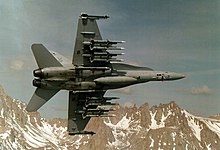.jpg) |
| The F/A-18 Hornet |
The McDonnell Douglas F/A-18 Hornet is a 4th generation combat aircraft that has twin engines, can fly supersonically, can be carried on ships, and can perform both fighter and attack missions, hence the F/A designation. The F/A-18 was developed by McDonnell Douglas and Northrop (now part of Northrop Grumman) to serve the United States Navy and Marine Corps in the 1970s. The Hornet is also used by the air forces of several other nations, and formerly by the U.S. Navy's Flight Demonstration Squadron, the Blue Angels.
The F/A-18 was designed to be a highly versatile aircraft due to its avionics, cockpit displays, and excellent aerodynamic characteristics, with the ability to carry a wide variety of weapons. The aircraft can perform fighter escort, fleet air defense, suppression of enemy air defenses, air interdiction, close air support, and aerial reconnaissance. Its versatility and reliability have proven it to be a valuable carrier asset, though it has been criticized for its lack of range and payload compared to its earlier contemporaries, such as the Grumman F-14 Tomcat in the fighter and strike fighter role, and the Grumman A-6 Intruder and LTV A-7 Corsair II in the attack role.
Specifications preview (F/A-18C/D)
- Crew: 1 (C)/2 (D - pilot and weapon systems officer)
- Length: 56 ft 1 in (17.1 m)
- Wingspan: 40 ft 4 in (12.3 m) with AIM-9 Sidewinders on wingtip LAU-7 launchers
- Width: 27 ft 7 in (8.4 m) wing folded
- Height: 15 ft 5 in (4.7 m)
- Wing area: 410 sq ft (38 m2)
- Aspect ratio: 4
- Airfoi l: root:NACA 65A005 mo d.; tip:NACA 65A003.5 mod.
- Empty weight: 23,000 lb (10,433 kg)
- Gross weight: 36,970 lb (16,769 kg)
- Max takeoff weight: 51,900 lb (23,541 kg)
- Fuel capacity: 10,860 pounds (4,930 kg) internally
- Powerplant: 2 × General Electric F404-GE-402 afterburning turbofan engines, 11,000 lbs (49 kN) thrust each dry, 17,750 lb (79.0 kN) with afterburner
Performance
- Maximum speed: 1,034 kn (1,190 mph, 1,915 km/h) at 40,000 ft (12,000 m)
- Maximum speed: Mach 1.8
- Cruise speed: 570 kn (660 mph, 1,060 km/h)
- Range: 1,089 nmi (1,253 mi, 2,017 km)
- Combat range: 400 nmi (460 mi, 740 km) air-air mission
- Ferry range: 1,800 nmi (2,100 mi, 3,300 km)
- Service ceiling: 50,000 ft (15,000 m)
- Rate of climb: 50,000 ft/min (250 m/s)
- Wing loading: 93 lb/sq ft (450 kg/m2)
- Thrust/weight: 0.96 (1.13 with loaded weight at 50% internal fuel)
Armament
- Guns: 1× 20 mm (0.787 in) M61A1 Vulcan nose mounted 6-barrel rotary cannon, 578 rounds
- Hardpoints: 9 total: 2× wingtips missile launch rail, 4× under-wing, and 3× under-fuselage with a capacity of 13,700 lb (6,200 kg) external fuel and ordnance, with provisions to carry combinations of:
- Rockets:
- 2.75 in (70 mm) Hydra 70 rockets
- 5 in (127.0 mm) Zuni rockets
- Missiles:
- Air-to-air missiles:
- 2× AIM-9 Sidewinder on wingtips and
- 8× AIM-9 Sidewinder (with double-racks) or 4× AIM-132 ASRAAM or 4× IRIS-T (EF-18A/B) or 8× AIM-120 AMRAAM (with double-racks) and
- 2× AIM-7 Sparrow or 2× AIM-120 AMRAAM
- Air-to-surface missiles:
- 4x AGM-65 Maverick
- AGM-84H/K Standoff Land Attack Missile Expanded Response (SLAM-ER)
- AGM-88 HARM Anti-radiation missile (ARM)
- 4x AGM-154 Joint Standoff Weapon (JSOW)
- AGM-158 Joint Air-to-Surface Standoff Missile (JASSM)
- Taurus Cruise missile
- Anti-ship missile:
- AGM-84 Harpoon
- Air-to-air missiles:
- Bombs:
- B83 nuclear bomb
- B61 nuclear bomb
- Joint Direct Attack Munition JDAM precision-guided munition (PGMs)
- Paveway series of laser-guided bombs
- Mk 80 series of unguided bombs
- CBU-78 Gator
- CBU-87 Combined Effects Munition
- CBU-97 Sensor Fuzed Weapon
- Mk 20 Rockeye II
- Mk 77 Incendiary bomb
- Other:
- ADM-141 TALD
- SUU-42A/A Flares/Infrared decoys dispenser pod and chaff pod or
- Electronic countermeasures (ECM) pod or
- AN/AAS-38 Nite Hawk Targeting pods (US Navy only), now being replaced by AN/ASQ-228 ATFLIR or
- LITENING targeting pod (USMC, Royal Australian Air Force, Spanish Air and Space Force, and Finnish Air Force only) or
- up to 3× 330 US gallons (270 imp gal; 1,200 L) Sargent Fletcher FPU-8/A drop tanks for ferry flight or extended range/loitering time.
- Rockets:
Avionics
- Hughes APG-73 radar
- ALR-67 radar warning receiver
- ROVER (Remotely Operated Video Enhanced Receiver) antenna for use by U.S. Navy's F/A-18C strike fighter squadrons
overview
Services: USN, USMC Armament: One M61A1/A2; AIM 9 Sidewinder, AIM 7 Sparrow, AIM-120 AMRAAM, Harpoon, Harm, SLAM, SLAM-ER, Maverick missiles; Joint Stand-Off Weapon; Joint Direct Attack Munition Propulsion: Two F404-GE-402 enhanced performance turbofan engines. Airspeed: Mach 1.7 Range: 1,089 nm
The F/A-18 demonstrated its capabilities and versatility during Operation Desert Storm, shooting down enemy fighters and subsequently bombing enemy targets with the same aircraft on the same mission, and breaking all records for tactical aircraft in availability, reliability, and maintainability.










0 Comments